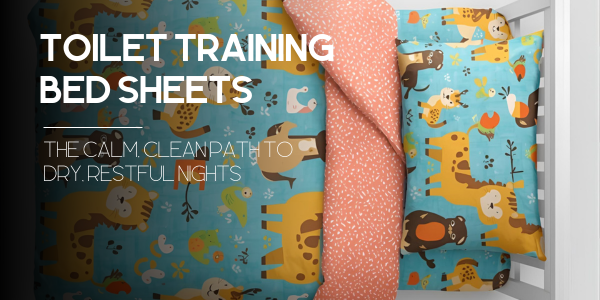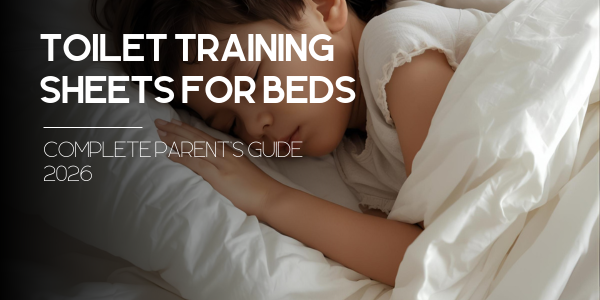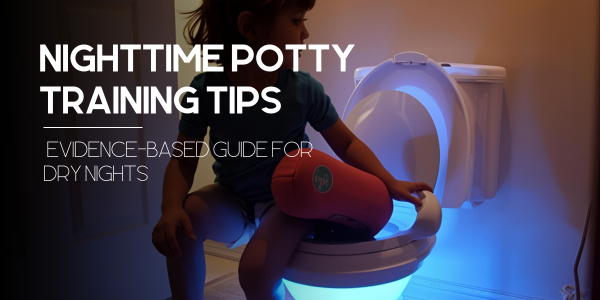Sleep Easy: The New Age of Hypoallergenic Incontinence Products for Sensitive Sleepers
Because every child deserves nights free from itches, worries, and midnight sheet changes.
Quick Wins for Skin-Safe Sleep
Bed-wetting affects 15% of 5-year-olds, but skin irritation doesn't have to be part of the journey. Hypoallergenic incontinence products are revolutionizing nighttime comfort—here's what you need to know:
Reframing Bed-Wetting with Empathy & Innovation
Picture this: It's 2 AM. Again. The familiar rustle of sheets, the quiet sniffle, the apologetic "Mom, I'm sorry..." echoing down the hallway. But tonight's different. Tonight, there's no red, angry rash greeting you. No tears from itchy skin. Just a quick change and back to dreamland.
That's the promise of hypoallergenic incontinence care—a revolution happening right under our noses (or should we say, under our sheets?).
Did you know? Approximately 15% of children at age 5 still experience nighttime bed-wetting. That's nearly 1 in 7 kids—you're not alone in this journey.
For too long, families have accepted that managing bed-wetting meant choosing between protection and comfort. Plastic sheets that crinkle. Diapers that cause rashes. Solutions that work but whisper "different" with every movement.
Enter the hypoallergenic revolution—where cutting-edge textile science meets genuine understanding of what families really need. This isn't just about staying dry anymore. It's about preserving dignity, protecting sensitive skin, and ensuring everyone gets the sleep they deserve.
What "Hypoallergenic" Really Means in Incontinence Care
Let's cut through the marketing fluff. "Hypoallergenic" gets thrown around like confetti at a parade, but when it comes to your child's skin, precision matters.
In clinical terms, hypoallergenic products are specifically formulated to minimize allergic reactions. For incontinence products, this means every material—from the absorbent core to the tiniest snap—has been scrutinized for potential irritants.
| Feature | Hypoallergenic Products | Conventional Products |
|---|---|---|
| Materials | Organic cotton, bamboo, plant-based TPU | Synthetic polymers, PVC, latex |
| Chemical Treatment | No chlorine bleaching, fragrance-free | Often bleached, may contain fragrances |
| Breathability | High air permeability (200+ gsm) | Limited breathability |
| Certifications | OEKO-TEX®, GOTS, dermatologist-tested | Basic safety standards only |
| Price Point | 15-30% premium for quality | Budget-focused |
The difference? It's like comparing a silk pillowcase to sandpaper. Both technically cover your pillow, but only one respects your skin.
Skin Science 101: Why Sensitive Sleepers React
Your child's skin is a marvel of engineering—but it's still under construction. The skin barrier in children is 20-30% thinner than in adults, making it more permeable to irritants and more prone to moisture loss.
The Perfect Storm for Irritation
When you combine thin skin with prolonged moisture exposure (hello, bed-wetting), you create what dermatologists call the "irritation trifecta":
- Moisture weakens the skin barrier
- Friction increases from movement during sleep
- pH changes create a breeding ground for irritation
Common Culprits Hiding in Conventional Products
Latex
Found in elastic waistbands. Causes reactions in 1-6% of the population, with higher rates in kids with spina bifida.
Chlorine Bleaching
Creates dioxin residues. While amounts are tiny, sensitive skin doesn't discriminate.
Nickel Snaps
The #1 cause of contact dermatitis. Yet they're everywhere in cheaper products.
Expert Insight: According to American Academy of Dermatology guidelines, "Minimizing chemical exposure in products that contact skin for extended periods is crucial for preventing contact dermatitis in pediatric populations."
This is why incontinence pads designed for sensitive skin have become game-changers for families dealing with both bed-wetting and skin sensitivities.
Material Matters: The Dream Team of Allergy-Friendly Fabrics
Forget everything you thought you knew about waterproof materials. The new generation of hypoallergenic fabrics reads like a love letter to sensitive skin:
Organic Cotton & Bamboo Terry: Nature's Comfort Duo

Imagine wrapping your child in a cloud that also happens to be incredibly absorbent. That's organic cotton terry. Zero pesticides during growth means zero chemical residues against skin. Bamboo takes it further—naturally antimicrobial without any added treatments.
- Breathability score: 10/10
- Softness factor: Like sleeping on a whisper
- Maintenance: Gets softer with each wash
Plant-Based TPU: The Waterproof Wonder
Gone are the days of choosing between "waterproof" and "breathable." Modern plant-based TPU (thermoplastic polyurethane) delivers both. Derived from plant oils rather than petroleum, it creates an impermeable barrier to liquids while allowing air molecules to pass through.
Science fact: Plant-based TPU can achieve waterproof ratings of 10,000mm+ while maintaining breathability ratings above 3,000g/m²/24hr. That's technical speak for "stays dry but doesn't feel like a plastic bag."
Zinc-Infused Fibers: Nature's Antimicrobial Shield
Here's where it gets exciting. Zinc—the same mineral in your diaper cream—can now be permanently bonded to fabric fibers. No washing out. No diminishing returns. Just consistent, natural protection against odor-causing bacteria.
These innovative materials come together beautifully in products like the Chooniez Organic Sleeping Bag, proving that eco-conscious choices and superior performance aren't mutually exclusive.
The Sustainability Bonus
Here's the kicker: hypoallergenic often means eco-friendly. When you eliminate harsh chemical treatments, you're not just protecting skin—you're protecting waterways. It's a win-win that would make Mother Earth herself sleep better at night.
Innovation Spotlight: 5 Product Categories Parents Should Know
The hypoallergenic revolution has spawned innovations that would've seemed like science fiction just a decade ago. Here are the game-changers reshaping nighttime confidence:
Ultra-Soft Waterproof Sheets
1Remember the crinkly plastic sheets of yesteryear? Today's versions use whisper-quiet TPU backing that's indistinguishable from regular bedding. The top layer? Pure organic cotton that actually gets softer with washing.
Key innovation: Silent-night technology with 360° stretch for zero bunching.
Learn why innovative bed sheets are transforming nighttime confidence.
Skin-Friendly Reusable Nighttime Pants
2Tagless designs meet stay-dry gussets in these engineering marvels. Built like regular underwear but with a hidden superpower: multi-layer absorbent cores that lock away moisture while keeping skin dry.
Parent favorite: Machine washable 300+ times without losing effectiveness.
Discover more about empowering bed-wetting underwear options.
Absorbent Boxer Briefs for Tweens
3Because dignity matters. These look exactly like trendy boxer briefs but pack serious protection. The waistband? Latex-free with encased elastic that never touches skin.
Confidence boost: Available in cool patterns that any tween would willingly wear.
Understanding teenage bed-wetting solutions starts with products that respect their need for normalcy.
Smart Moisture-Sensing Alarms
4Forget jarring buzzers. Modern alarms use gentle vibration and graduated light to wake children naturally. Hypoallergenic sensors clip to underwear with nickel-free fasteners.
Tech twist: Some sync with apps to track progress and celebrate dry nights.
Explore how bed-wetting devices work in our comprehensive guide.
Travel-Ready Seat Protectors
5Portable protection that doesn't scream "medical device." These fold into discrete carrying cases and feature hypoallergenic top layers perfect for car seats, strollers, or grandma's couch.
Design win: Stylish patterns that blend with any decor.
Don't miss our versatile throw blanket solution for on-the-go protection.
Lily's 30-Night Transformation with Chooniez
Meet Lily, Age 7
Chronic eczema + nighttime bed-wetting = a perfect storm of skin irritation
When Lily's mom Sarah first contacted us, she was at her wit's end. "We'd tried everything," she shared. "But every morning brought new rashes, new tears. Lily started refusing sleepovers. My confident little girl was disappearing."
The game plan? A complete hypoallergenic overhaul:
- Switched to Chooniez organic cotton mattress protector
- Introduced zinc-infused reusable nighttime underwear
- Implemented a fragrance-free washing routine
- Added breathable bed pads for extra protection
Dr. Emily Chen, Pediatric Dermatologist: "The correlation between hypoallergenic bedding materials and reduced incidence of contact dermatitis in bed-wetting children is remarkable. Cases like Lily's demonstrate that addressing skin sensitivity alongside incontinence management yields exponentially better outcomes."
Sarah's update after 30 nights? "It's not just about dry sheets anymore. It's about seeing my daughter's smile return. She had her first sleepover last week—packed her Chooniez products with pride, not shame."
Step-by-Step Buyer's Guide (Parents & Kids Co-Decision)
Choosing hypoallergenic incontinence products isn't just a purchase—it's a partnership. Here's how to make selections that work for everyone:
Step 1: Assess Sensitivity Triggers Together
Quick Sensitivity Check (Do this with your child!):
If you answered yes to any of these, prioritize certified hypoallergenic products.
Step 2: Decode the Certifications
Not all certifications are created equal. Here's your decoder ring:
- OEKO-TEX® Standard 100: Tests for 100+ harmful substances. The gold standard.
- GOTS (Global Organic Textile Standard): Ensures organic fibers + ethical production.
- Dermatologically Tested: Actually tested on human skin (ethically, of course).
Step 3: Prioritize Breathability Over Bulk
Here's a secret: thicker doesn't mean better. Look for these breathability indicators:
GSM Sweet Spot: 200-300 GSM (grams per square meter) offers optimal absorption without sacrificing airflow. Higher isn't always better—it's about smart layering, not sheer thickness.
Step 4: Choose Correct Absorbency
One size doesn't fit all nights. Consider creating an absorbency strategy with different bed pad options:
- Light: For occasional dribbles or kids nearly dry
- Moderate: Standard protection for most situations
- Heavy: For deep sleepers or medication-related incontinence
- Maximum: When you need Fort Knox-level protection
Step 5: Involve the Child—Make It Their Victory
This is crucial. Let them:
- Choose between pattern options
- Feel different fabric samples
- Help set up their new bedding
- Track dry nights on a special calendar
When kids feel ownership over the solution, shame transforms into empowerment. Speaking of empowerment, these inspiring bed-wetting stories show just how powerful the right approach can be.

Future-Forward Trends: Where Hypoallergenic Incontinence Tech Is Headed
Buckle up—the future of skin-safe incontinence care looks like something out of a sci-fi novel (but in the best way possible):
Bio-Based Polyurethane Films: The Next Frontier
Scientists are developing waterproof barriers from algae and mushroom mycelium. Yes, you read that right. These materials biodegrade completely while offering superior breathability. Expect to see them hit mainstream markets by 2027.
Phase-Change Cooling Microcapsules
Imagine bedding that automatically cools when skin temperature rises. NASA-developed phase-change materials are being woven into incontinence products to prevent the heat buildup that exacerbates skin irritation. Summer bed-wetting solutions are about to get a whole lot cooler—literally.
Circular Economy Take-Back Programs
Chooniez is pioneering programs where worn-out products get transformed into playground surfaces and park benches. It's sustainability meets social responsibility—turning yesterday's protection into tomorrow's community assets.
AI-Driven Sizing & Skin-Type Matching
Upload a photo, answer three questions, and AI recommends the perfect product for your child's unique body type and skin sensitivity level. No more guessing games or costly size mistakes.
Coming Soon: Smart fabrics that change color to indicate saturation levels—taking the guesswork out of when to change. Privacy-preserving and dignity-maintaining, because technology should enhance confidence, not compromise it.
Hypoallergenic Incontinence Products -FAQs
Absolutely. While you'll pay 15-30% more upfront, you'll save on diaper rash creams, doctor visits for skin issues, and replacement products. Most families break even within 3 months when factoring in the extended lifespan of quality hypoallergenic products. Plus, can you really put a price on itch-free, confident mornings?
Steer clear of latex, PVC, products with optical brighteners, anything with added fragrances, and materials treated with formaldehyde-releasing preservatives. Also watch for nickel in snaps or elastics. When in doubt, choose products specifically labeled "eczema-friendly" with certifications to back it up.
Organic cotton alone isn't waterproof, but when paired with plant-based TPU lamination, it creates an impermeable barrier. The magic is in the layering—organic cotton touches skin while TPU handles the waterproofing. This combo delivers both comfort and protection without compromising on either. Modern lamination techniques ensure the TPU layer is ultra-thin yet incredibly effective.
For optimal hygiene and to maintain hypoallergenic properties, wash every 1-2 weeks during active use, or immediately after any accident. Use hot water (at least 140°F) to eliminate dust mites and bacteria. Pro tip: Having two protectors allows for rotation, ensuring you're never without protection. Learn more about science-backed washing techniques.
Myth-Buster Mini-Section
Myth: Hypoallergenic products are less absorbent
Reality: Modern hypoallergenic products often outperform conventional options. Chooniez's organic cotton bed pads, for instance, can absorb up to 6 cups of liquid—that's 20% more than many synthetic alternatives. The secret? Natural fibers have superior wicking properties when properly engineered.
Myth: Only babies need allergy-free diapers
Truth: Skin sensitivity doesn't have an age limit. In fact, tweens and teens often develop new sensitivities during hormonal changes. Plus, the emotional comfort of knowing their protection won't cause itching or rashes? That's priceless at any age. Don't believe us? These stories about teenage bed-wetting realities might change your mind.
Remember: rubber sheets are so last century. Today's solutions respect both skin and dignity.
Your Journey to Skin-Safe, Confident Nights Starts Now
We've covered a lot of ground—from the science of sensitive skin to the future of smart fabrics. But here's what matters most: every child deserves to wake up comfortable, confident, and ready to conquer their day.
Bed-wetting is temporary. The memories you create handling it with grace, innovation, and skin-safe solutions? Those last forever.
Whether your child is 7 and still learning nighttime control or navigating the complexities of being 8 with occasional accidents, remember: this is development, not failure.
Ready to revolutionize your nights?
Download our FREE "Skin-Safe Sleep Checklist" and discover exactly which products will work for your family's unique needs.
Explore Chooniez Hypoallergenic Range →Because at Chooniez, we believe protection should never come at the cost of comfort. Here's to itch-free mornings, confident kids, and parents who sleep soundly knowing they've chosen the very best.







Leave a comment